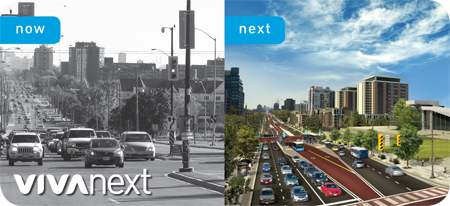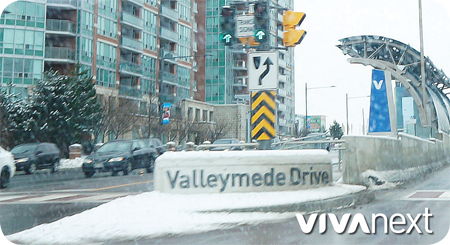VivaNext is committed to designing and delivering an exceptional rapid transit system – one that will help shape growth in our communities, connect York Region’s urban centres and provide faster, more reliable and congestion-free trips. The vivaNext rapidway in Vaughan is more than just a transit project. It also includes urban design elements such as pedestrian-friendly boulevards, wider sidewalks, attractive landscaping, bicycle lanes and green open spaces for the whole community to enjoy. Check out this video and take a ride with us along the corridor to see what is happening.
As you can see, the transformation along Highway 7 West is well underway. Last year, in the Vaughan Metropolitan Centre [VMC] area (also known as phase one of the vivaNext project in Vaughan) crews were busy removing signs, and relocating utilities in preparation for construction.
This year, you will see significant construction activity in this segment. Traffic lanes will be shifted and bus stops will be relocated in order for crews to continue infrastructure work for hydro, gas, storm drains, watermains and begin road widening. Construction has also started on the south side of the Canadian National Railway [CN] Bridge, located west of Keele Street. The bridge surface will be widened approximately 8-metres to accommodate dedicated rapidway lanes, sidewalks and bicycle lanes.
In the phase 2 area east and west of VMC, crews will be working intermittently along the corridor on preliminary construction activities such as soil sampling and other environmental investigations.
Work on the Toronto-York Spadina Subway Extension [TYSSE] also continues this year. When completed, this subway line will include six stops, 8.6 kilometres of track. Residents and visitors alike will enjoy the mixed-use, transit-oriented development offered in the VMC area, including convenient passenger pick-up and drop-off, a York Region Transit bus terminal, and connection to the Viva rapidway running in dedicated lanes east and west along Highway 7. It will be a great place to work, shop or relax, and getting there will be easy whether you walk or ride transit.
Throughout construction, we’ll keep everyone informed and minimize disruptions as much as possible for those who live, work and commute in Vaughan. For more information on any of these projects, or to sign up for construction notices so you can stay in the loop, visit vivanext.com.










